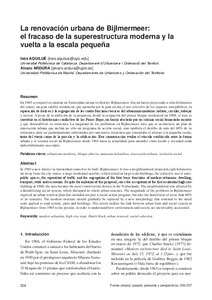Mostra el registre d'ítem simple
La renovación urbana de Bijlmermeer: el fracaso de la superestructura moderna y la vuelta a la escala pequeña
| dc.contributor.author | Aquilué Junyent, Inés |
| dc.contributor.author | Ardura, Álvaro |
| dc.contributor.other | Universitat Politècnica de Catalunya. Departament d'Urbanisme i Ordenació del Territori |
| dc.coverage.spatial | east=4.966069400000038; north=52.3195108; name=Bijlmer-Oost, Amsterdam-Zuidoost, Països Baixos |
| dc.date.accessioned | 2018-01-10T14:57:06Z |
| dc.date.available | 2018-01-10T14:57:06Z |
| dc.date.issued | 2017 |
| dc.identifier.citation | Aquilue, I., Ardura, Á. La renovación urbana de Bijlmermeer: el fracaso de la superestructura moderna y la vuelta a la escala pequeña. A: I Congreso ISUF-H. "Forma urbana, pasado, presente y perspectivas. Actas del I Congreso ISUF-H.". Toledo: Ediciones de la Universidad de Castilla-La Mancha (UCLM), 2017, p. 226-237. |
| dc.identifier.uri | http://hdl.handle.net/2117/112601 |
| dc.description.abstract | In 1965 a new district in Amsterdam started to be built: Bijlmermeer. It was a neighbourhood projected eight kilometres far away from the city centre: a large residential satellite, which relied on large scale buildings, the collective use of semipublic spaces, the separation of traffic and the segregation of the four basic functions of modern urbanism: dwelling, transport, work and recreation. Despite the ambition of this proposal, since the occupation of the first residential high-rise building in 1968, the area became the most controversial district in the Netherlands. The neighbourhood was affected by a destabilizing social system, which disrupted its whole urban structure. The magnitude of the problems in Bijlmermeer required an urban renewal plan that included not just a social action program, but also the demolition of more than 60% of its structure. The modern structure should gradually be replaced by a new morphology that returned to the small scale applied to road system, plots and buildings. This article tackles the link between urban form and social system in Bijlmermeer from 1965 to the present, in order to understand how environment and society are inextricably associated. |
| dc.format.extent | 12 p. |
| dc.language.iso | eng |
| dc.publisher | Ediciones de la Universidad de Castilla-La Mancha (UCLM) |
| dc.rights | Attribution-NonCommercial-NoDerivs 3.0 Spain |
| dc.rights.uri | http://creativecommons.org/licenses/by-nc-nd/3.0/es/ |
| dc.subject | Àrees temàtiques de la UPC::Urbanisme::Planejament urbà |
| dc.subject.lcsh | Urban renewal |
| dc.subject.other | Modern urbanism |
| dc.subject.other | High-rise state |
| dc.subject.other | Dutch block |
| dc.subject.other | Urban renewal |
| dc.subject.other | Social cohesion |
| dc.title | La renovación urbana de Bijlmermeer: el fracaso de la superestructura moderna y la vuelta a la escala pequeña |
| dc.type | Conference lecture |
| dc.subject.lemac | Rehabilitació urbana |
| dc.contributor.group | Universitat Politècnica de Catalunya. GRU - Grup de Recerca Urbanisme |
| dc.identifier.doi | 10.18239/jor_12.2017.04 |
| dc.rights.access | Open Access |
| local.identifier.drac | 21687612 |
| dc.description.version | Postprint (published version) |
| local.citation.author | Aquilue, I.; Ardura, Á. |
| local.citation.contributor | I Congreso ISUF-H |
| local.citation.pubplace | Toledo |
| local.citation.publicationName | Forma urbana, pasado, presente y perspectivas. Actas del I Congreso ISUF-H. |
| local.citation.startingPage | 226 |
| local.citation.endingPage | 237 |


